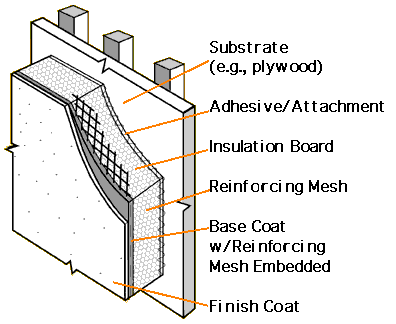EIFS Features
Products
What The Hell Is C-Glass Mesh?

If I had a dollar for every time I have been asked this question......Well, maybe $10, then I would have increased sales significantly here at Sunline Technical Fabrics. Jokes aside, it is a very valid question and one that I am actually happy to answer for my customers so they are better informed when they are deciding what EIFS mesh to buy. Many purchasing managers and owners of stores or even contractors have no idea that mesh is available in different grades. Several years ago this was not so much of consideration, when the economy was stronger here in the US. At this time, more of my customers and many users of EIFS in the building industry demanded and were accustomed to using E-Glass mesh.
So, what are E-Glass and C-Glass exactly? Well, first E-Glass. This is the grade of mesh that Drivit, Sto, Senergy and Parex manufacture. It is the highest grade of EIFS mesh available on the market. What determines this quality? The type of fiberglass inside the strands. EIFS mesh is composed of fiberglass coated in plastic, which is then woven into strands. A better quality, more expensive fiberglass creates a better quality, more expensive mesh. E-Glass mesh will be very flexible for its weight. It is very unlikely to snap. You can test this by bending the mesh back and forth in your hands a number of times and watching whether the strands snap. Once E-Glass has been applied correctly into an EIFS wall, it is very unlikely that the wall will crack or not perform its designed function of reinforcing a wall. We all know of or have heard of the issues with EIFS. Some of these issues, like cracking or the wall basically falling apart can be due to not using the best quality mesh.
So why then, you ask would anyone want to use anything but E-Glass? It comes down to cost. In this economy where we all want to save as much money and cut costs where possible, customers desire a less expensive mesh. C-Glass is considerably cheaper (by $4 a roll here at Sunline Technical Fabrics) After explaining to my customers the qualities of E-Glass and the price difference, I am then asked why C-Glass is cheaper. What I tell them is that whilst the fiberglass used is not quite of the same high quality and marginally less flexible. It will hold up well in a wall system though. Most importantly it still meets building code. Anything less than C-Glass does not meet building code. Using this kind of mesh in buildings is very dangerous and will very likely end up causing failure of the EIFS wall. C-Glass can be a very good alternative to E-Glass.
Hence, knowing what grade of mesh you are purchasing is important. Unfortunately due to the strong demand for very cheap mesh there is mesh being manufactured and sold that does not meet building code. This mesh is quite obviously substandard when you manipulate it in your hands or try to apply it on the job site. Some buyers are not aware that this will be the case when they seek out the $25 a roll or less mesh (I am referring to 38” x 150' size rolls) and some don't give a shit, being of the mind that once the building is up, the safety and life of the building is not their concern.
So how to know what grade of mesh you are buying? Firstly ask your supplier what grade they manufacture or distribute? If they don't know, there is a good chance that it is substandard. Secondly, ask for a sample. When you get it in your hands, if the strands snap after bending it back and forth many times or when you pull it in different directions, it is crap. Also if it feels very brittle and not soft and flexible this is a sure sign. The third indication is price. $30 and above per roll mesh should be E-Glass, around $26 a roll is average for C-Glass and $25 and below you can expect to be the lowest quality mesh that does not meet building code.
Be informed and responsible with your purchases to make the best decision for your budget, your reputation as a store or contractor and in order to do right by the home or building owner.
What is EIFS?

Exterior Insulation and Finish Systems (EIFS) are multi-layered exterior wall systems that are used on both commercial buildings and homes. They provide superior energy efficiency, insulation and offer much greater design flexibility than other cladding products. They are also offer cost savings over other materials. Developed in Europe in the 1950s, EIFS were introduced in the U.S. almost 40 years ago. They were first used on commercial buildings, and later, on homes. Today, EIFS account for nearly 30% of the U.S. commercial exterior wall market. EIFS typically consist of the following components: * insulation board, made of polystyrene or polyisocyanurate foam, which is secured to the exterior wall surface with a specially formulated adhesive and/or mechanical attachment such as fasteners. * a durable, water-resistant base coat, which is applied on top of the insulation and reinforced with fiber glass mesh for added strength * an attractive and durable finish coat -- typically using acrylic co-polymer technology -- which is both colorfast and crack-resistant. The growing popularity of EIFS is due to the fact that few, if any, competitive materials offer such a wide range of desirable product benefits. Chief among these are superior energy efficiency and virtually unlimited design flexibility.
How to Order from Us
Email all orders to :info@sunlinemesh.com for fastest processing. Our Director of Marketing is waiting to assist you with product specs, sample requests or any additional information. You may also call us at: 877-568-5507